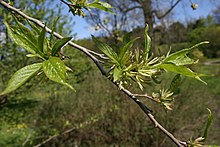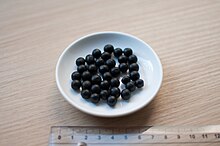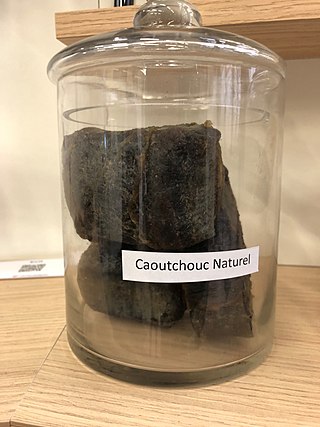
Rubber, also called India rubber, latex, Amazonian rubber, caucho, or caoutchouc, as initially produced, consists of polymers of the organic compound isoprene, with minor impurities of other organic compounds. Thailand, Malaysia, Indonesia, and Cambodia are four of the leading rubber producers.
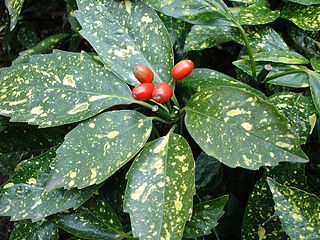
The Garryales are a small order of dicotyledons, including only two families and three genera.

Gutta-percha is a tree of the genus Palaquium in the family Sapotaceae. The name also refers to the rigid, naturally biologically inert, resilient, electrically nonconductive, thermoplastic latex derived from the tree, particularly from Palaquium gutta; it is a polymer of isoprene which forms a rubber-like elastomer.

Hevea brasiliensis, the Pará rubber tree, sharinga tree, seringueira, or most commonly, rubber tree or rubber plant, is a flowering plant belonging to the spurge family Euphorbiaceae originally native to the Amazon basin, but is now pantropical in distribution due to introductions. It is the most economically important member of the genus Hevea because the milky latex extracted from the tree is the primary source of natural rubber.

Manilkara bidentata is a species of Manilkara native to a large area of northern South America, Central America and the Caribbean. Common names include bulletwood, balatá, ausubo, massaranduba, quinilla, and (ambiguously) "cow-tree".

Ficus benjamina, commonly known as weeping fig, benjamin fig or ficus tree, and often sold in stores as just ficus, is a species of flowering plant in the family Moraceae, native to Asia and Australia. It is the official tree of Bangkok. The species is also naturalized in the West Indies and in the states of Florida and Arizona in the United States. In its native range, its small fruit are favored by some birds.

Ficus elastica, the rubber fig, rubber bush, rubber tree, rubber plant, or Indian rubber bush, Indian rubber tree, is a species of flowering plant in the family Moraceae, native to eastern parts of South and Southeast Asia. It has become naturalized in Sri Lanka, the West Indies, and the US state of Florida. Despite its common names, it is not used in the commercial production of natural rubber.
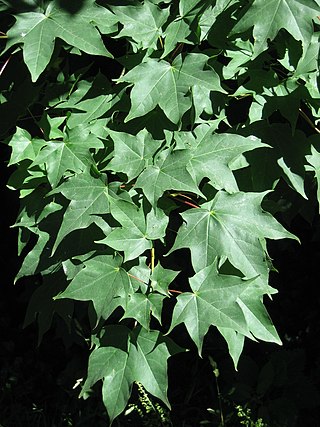
Acer cappadocicum, the Cappadocian maple, is a maple native to Asia, from central Turkey east along the Caucasus, the Himalayas, to southwestern China.

Polyisoprene is strictly speaking a collective name for polymers that are produced by polymerization of isoprene. In practice polyisoprene is commonly used to refer to synthetic cis-1,4-polyisoprene, made by the industrial polymerisation of isoprene. Natural forms of polyisoprene are also used in substantial quantities, the most important being "natural rubber", which is derived from the sap of trees. Both synthetic polyisoprene and natural rubber are highly elastic and consequently used to make tires and a variety of other applications.

The flora of China consists of a diverse range of plant species including over 39,000 vascular plants, 27,000 species of fungi and 3000 species of bryophytes. More than 30,000 plant species are native to China, representing nearly one-eighth of the world's total plant species, including thousands found nowhere else on Earth. China's land, extending over 9.6 million km, contains a variety of ecosystems and climates for plants to grow in. Some of the main climates include shores, tropical and subtropical forests, deserts, elevated plateaus and mountains. The events of the continental drift and early Paleozoic Caledonian movement also play a part in creating climatic and geographical diversity resulting in high levels of endemic vascular flora. These landscapes provide different ecosystems and climates for plants to grow in, creating a wide variety of different flora spanning over not just China, but different parts of the world.

Manilkara huberi, also known as masaranduba, níspero, and sapotilla, is a fruit bearing plant of the genus Manilkara of the family Sapotaceae.

Eucommia is a genus of small trees now native to China, with a fossil record that shows a much wider distribution. The single living species, Eucommia ulmoides, is near threatened in the wild, but is widely cultivated in China for its bark, and is highly valued in herbology such as traditional Chinese medicine.
Eucommia eocenica is an extinct species of flowering plant in the family Eucommiaceae. E. eocenica is known from fossil fruits found in the middle Eocene Claiborne Formation deposits of the southeastern United States. E. eocenica is one of five described fossil species from North America assigned to the modern genus Eucommia. The other species are E. constans, E. jeffersonensis, E. montana, and E. rowlandii.
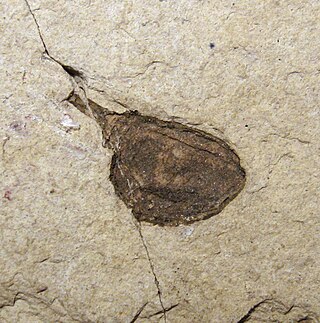
Eucommia montana is an extinct species of flowering plant in the family Eucommiaceae. E. montana is known from fossil fruits found in Eocene deposits of the northwestern United States southeastern British Columbia south to Oregon and east to Montana and Colorado. E. montana is one of five described fossil species from North America assigned to the modern genus Eucommia. The other species are E. constans, E. eocenica, E. jeffersonensis, and E. rowlandii.
Eucommia constans is an extinct species of flowering plant in the family Eucommiaceae. Eucommia is a genus of small trees now native to China, with a fossil record that shows a much wider distribution. E. constans is known from fossil fruits found in Miocene to Pleistocene deposits of east-central Mexico. E. constans is one of five described fossil species from North America assigned to the modern genus Eucommia. The other species are E. eocenica, E. jeffersonensis, E. montana, and E. rowlandii.
Eucommia jeffersonensis is an extinct species of flowering plant in the family Eucommiaceae. It is known from a fossil fruit found in latest Eocene deposits of Oregon, United States. E. jeffersonensis is one of five described fossil species from North America assigned to the modern genus Eucommia. The other species are E. constans, E. eocenica, E. montana, and E. rolandii.
Eucommia rolandii is an extinct species of flowering plant in the family Eucommiaceae. E. rolandii is known from four fossil leaves found in Middle Eocene deposits of British Columbia, Canada and Mississippi, United States. E. rolandii is one of five described fossil species from North America assigned to the modern genus Eucommia. The other species are E. constans, E. eocenica, E. jeffersonensis, and E. montana.

Palaquium gutta is a tree in the family Sapotaceae. The specific epithet gutta is from the Malay word getah meaning "sap or latex". It is known in Indonesia as karet oblong.
Palaquium hexandrum is a tree in the family Sapotaceae. The specific epithet hexandrum means "six stamens", referring to the flowers.
Palaquium obovatum is a tree in the family Sapotaceae. The specific epithet obovatum means "egg-shaped", referring to the leaves.
